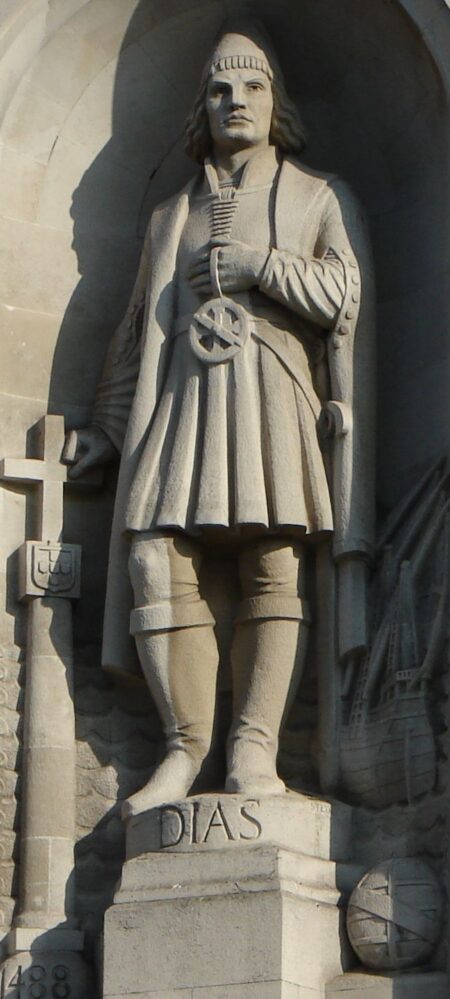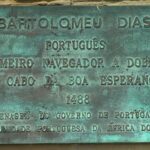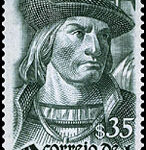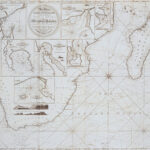Bartolomeu Dias
Explorer
Age of Discovery
Quick Facts:
He was the first European explorer to sail around the tip of Africa, proving the Atlantic Ocean connects to the Indian Ocean, which opened opportunities for a new trade route to India.
Introduction
Bartolomeu Dias was the first European explorer to sail around the southern coast of Africa successfully. In 1488, Dias proved that a sea trading route from Europe to Asia was possible. The coast of Africa often had terrible storms which often deterred explorers. But with some luck and skill, Dias navigated these waters to open a new way to reach India from Europe.
Biography
Early Life
Very little is known about Bartolomeu Dias’ (also spelled Bartholomew Diaz) early life. He was born in 1450 near Lisbon, Portugal.1 He was raised in a noble family, so he may have received a good education. By his mid-thirties, Dias worked in the Portuguese royal court in charge of the crown’s warehouse goods.2 Although he grew up in the mighty seafaring nation of Portugal, there is no detailed account of how Dias gained his sailing experience. He took a trip with a nobleman named Diogo de Azambuja in 1481. They traveled down to the Gold Coast in Africa to a Portuguese fort on the Gulf of Guinea.3 During this time, Portugal was heavily exploring the African continent. They hoped to find a trade route from Europe to Asia by going around Africa. Despite many attempts, the Portuguese explorers had been unsuccessful.
Much of Portuguese exploration began with Prince Henry the Navigator. Prince Henry, however, did not really do much sailing. He is responsible for Portugal’s age of exploration. He was born in 1394 and was the son of King John I and his English wife Philippa of Lancaster. Much of the trade routes to India during this time were held by Arab traders who often charged high taxes on incoming and outgoing goods. From about 1419 until his death in 1460, Prince Henry sent several sailing expeditions down the coast of Africa.4 They were unsuccessful. In 1481, King John II of Portugal began sending expeditions to find a sea route around the southern shores of Africa. Diogo Cão was one of the first captains to attempt this voyage. He reached the Congo River, and sailed down along Angola’s coast where he planted a marker in King John’s name. He continued south down Namibia where another marker was left at Cape Cross.5 After this, not much is known what happened to Cão. However, he did not reach the Indian Ocean. In October 1486 King John II appointed Dias as the head of an expedition to find a trade route to India. It took a year of preparation before Bartolomeu Dias began his journey.
Voyages
Principal Voyage
Bartolomeu Dias set sail from Lisbon, Portugal in August 1487. His fleet had three ships. Dias commanded the caravel São Cristóvão. The São Pantaleão was commanded by one of Dias’ associates, and the third vessel was a supply ship. He traveled down the West African coast. He passed Cão’s markers. Dias reached Walvis Bay, Namibia on December 8. He pressed on and reached the Elizabeth Bay on December 26. However,in 1488, fierce storms drove his fleet south. For Dias made his way to open waters away from the coast and sailed there for several days. Having lost sight of the land, Dias changed course and headed north. Finally, on February 3, 1488, Dias reached Mossel Bay, South Africa. He had passed Africa’s southern tip.
Dias rounded the cape and landed. Since it was the day of the Feast of St. Blaise, Dias named the spot Angra de São Brás – Portuguese for Bay of St. Blaise. Here, he encountered a group of African natives. At first, the natives fled from Dias and his men. But they returned and attacked the Portuguese crew.6 Dias continued sailing on. He reached the farther point of his journey on March 12 when they reached Algoa Bay. They erected a large stone cross and claimed the land for Portugal.7 Dias, was determined to make his way to India. He wanted to press on, but his crew tired and running low on supplies so they refused to go farther. Dias had no choice but to head back for Portugal.
Subsequent Voyages
It was not until Dias’ return trip to Portugal that he saw the cape where the Atlantic Ocean meets the Indian Ocean. Dias named the spot the Cape of Storms after all the terrible storms that occurred there. However, it would later be renamed Cape of Good Hope by King John II to encourage travel and trade in the region. Dias returned home to Lisbon in December 1488, where he made reports of his journey to King John II. While plans may have been made for another voyage upon Dias’ return home, it would be another nine years before he set out on an expedition again. He spent these years building ships. He helped build two ships, including the São Gabriel, that were used by Vasco da Gama. Dias joined da Gama in 1497 for his expedition to circumnavigate Africa to reach India. Dias only went as far as the Cape Verde Islands, where he parted ways with da Gama.8 Vasco da Gama went on to reach India in May 1498.
Later Years and Death
Not much is known about Dias’ later life. He made two recorded voyages after his return to Portugal from Africa. His second voyage would be his last. In 1500 Dias commanded four ships in an expeditionary force led by Pedro Alvarez Cabral. During this voyage, they would be the first Europeans to spot Brazil. In May 1500, Dias was caught in a terrible storm off the Cape of Good Hope. He died when his ship sank, along with three other vessels.
Legacy
Bartolomeu Dias never made it to India. But he did discover that a sea trade route to Asia was possible by going around Africa. His voyage changed the map of the known world at the time. By showing that the African continent ended and that there was a link between the Atlantic and the Indian Ocean, Dias opened a route for future explorers and merchants. Dias’ contributions are honored at the Bartolomeu Dias Museum Complex in Mossel Bay, the place where Dias first landed after rounding the cape during his voyage.
Images
Endnotes
- Encyclopaedia Britannica, Inc, Britannica Student Encyclopedia, (Chicago: Encyclopaedia Britannica, Inc., 2014), 44.
- Emmanuel Akyeampong and Henry Louis Gates, Dictionary of African Biography (Oxford : Oxford University Press, 2012), 194.
- Akyeampong and Gates, Dictionary of African Biography, 194.
- Aileen Gallagher, Prince Henry, the Navigator: Pioneer of Modern Exploration (New York: The Rosen Publishing Group, Inc., 2003), 5.
- Kenneth Pletcher, ed., The Britannica Guide to Explorers and Explorations That Changed the Modern World (New York: The Rosen Publishing Group, 2009), 51.
- Pletcher, The Britannica Guide , 52.
- Akyeampong and Gates, Dictionary of African Biography, 194.
- Akyeampong and Gates, Dictionary of African Biography, 194.




